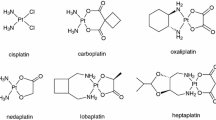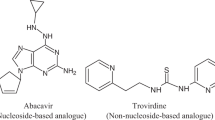Abstract
The potent activities of many anticancer agents have been demonstrated by in vitro assays. However, their poor solubility may result in diminishing anticancer activities in vivo. Previously, we synthesized a series of bisacridine derivatives shown to be potent in cytotoxicity and DNA intercalating activity in vitro. Initially, the compound 1, (N-(6-chloro-2-methoxy-acridin-9-yl)-N′-[3-(6-chloro-2-methoxy-acridin-9-ylamino)-propyl]-propane-1,3-diamine), is insoluble in polar solvent and does not reveal antihuman COLO 205 solid-tumor activity in vivo. To enhance its solubility, three salt forms (CH3COOH, CH3SO3H, and CF3COOH) of compound 1 were synthesized and their solubility was found to be greatly improved compared with that of the free base. Among these salts, the compound 1 · (tris)acetate salt has shown good solubility in H2O and 2.5% Cremophor (v/v) and demonstrated anti-COLO205 solid-tumor activity in vivo.





Similar content being viewed by others
Abbreviations
- Compound 1 :
-
N-(6-Chloro-2-methoxy-acridin-9-yl)-N′-[3-(6-chloro-2-methoxy-acridin-9-ylamino)-propyl]-propane-1,3-diamine
- Compound 2 :
-
Compound 1 · 3CH3COOH
- Compound 3 :
-
Compound 1 · CH3SO3H
- Compound 4 :
-
Compound 1 · 3CF3COOH
References
Antonini I, Cola D, Polucci P, Bontemps-Gracz M, Borowski E, Martelli S (1995) Synthesis of (dialkylamino)alkyl-disubstituted pyrimido[5,6,1-de]acridines, a novel group of anticancer agents active on a multidrug resistant cell line. J Med Chem 38:3282–3286. doi:10.1021/jm00017a013
Antonini I, Polucci P, Magnano A, Martelli S (2001) Synthesis, antitumor cytotoxicity, and DNA-binding of novel N-5,2-Di(ω-aminoalkyl)-2, 6-dihydropyrazolo[3,4,5-kl]acridine-5-carboxamides. J Med Chem 44:3329–3333. doi:10.1021/jm010917o
Antonini I, Polucci P, Magnano A, Gatto B, Palumbo M, Menta E, Pescalli N, Martelli S (2003) Synthesis, and biological properties of new bis(acridine-4-carboxamides) as anticancer agents. J Med Chem 46:3109–3115. doi:10.1021/jm030820x
Atwell GJ, Cain BF, Seelye RN (1972) Potential antitumor agents. 12. 9-Anilinoacridines. J Med Chem 15:611–615. doi:10.1021/jm00276a011
Bousquet PF, Brana MF, Conlon D, Fitzgerald KM, Perron D, Cocchiaro C, Miller R, Moran M, George J, Qian XD (1995) Preclinical Evaluation of LU 79553: a novel bis-naphthalimide with potent antitumor activity. Cancer Res 55:1176–1180
Brana MF, Castellano JM, Perron D, Maher C, Conlon D, Bousquet PF, George J, Qian XD, Robinson SP (1997) Chromophore-modified bis-naphthalimides: synthesis and antitumor activity of bis-dibenz[de, h]isoquinoline-1,3-diones. J Med Chem 40:449–454. doi:10.1021/jm960295k
Bridewell DL, Finlay GL, Baguley BC (2001) Topoisomerase I/II selectivity among derivatives of N-[2-(dimethylamino)ethyl]-acridine-4-carboxamide (DACA). Anticancer Drug Des 16:317–324
Caponigro F, Dittrich C, Sorensen JB, Schellens JH, Duffaud F, Paz Ares L, Lacombe D, de Balincourt C, Fumoleau P (2002) Phase II study of XR 5000, an inhibitor of topoisomerase I and II, in advanced colorectal cancer. Eur J Cancer 38:70–74. doi:10.1016/S0959-8049(01)00336-7
Charmantray F, Demeunynck M, Carrez D, Croisy A, Lansiaux A, Bailly C, Colson P (2003) 4-Hydroxymethyl-3-aminoacridine derivatives as a new family of anticancer agents. J Med Chem 46:967–977. doi:10.1021/jm020389w
Chen TK, Fico R, Canellakis ES (1978) Disacridine, bifunctional intercalators. Chemistry and antitumor activity. J Med Chem 21:868–874. doi:10.1021/jm00207a006
Cholody WM, Hernandez L, Hassner L, Scudiero DA, Djurickovic DB, Michejda CJ (1995) Bisimidazoacridones and related compounds: new antineoplastic agents with high selectivity against colon tumors. J Med Chem 38:3043–3052. doi:10.1021/jm00016a007
Gamage SA, Spicer JA, Atwell GL, Finlay GJ, Baguley BC, Denny WA (1999) Structure-activity relationships for substituted bis(acridine-4-carboxamides): a new class of anticancer agents. J Med Chem 42:2383–2393. doi:10.1021/jm980687m
Gaugain B, Barbet J, Oberlin R, Roques BP, Le Pecq JB (1978) DNA bifunctional intercalators. 1. Synthesis and conformational properties of an ethidium homodimer and an acridine ethidium heterodimer. Biochemistry 17:5071–5078. doi:10.1021/bi00617a001
Hernandez L, Cholody WM, Hudson EA, Resau JH, Pauly G, Michejda CJ (1995) Mechansim of action of bisimidazoacridones, new drugs with potent, selective activity against colon cancer. Cancer Res 55:2338–2345
Huan SD, Natale RB, Steward DJ, Sartiano GP, Stella PJ, Roberts JD, Symes AL, Finizio M (2000) A multicenter phase II trial of losoxantrone (DuP-941) in hormone-refractory metastatic prostate cancer. Clin Cancer Res 6:1333–1336
Krapcho PA, Petry ME, Getahun Z, Landi JJ Jr, Stallman J, Polsenberg JF, Gallagher CE, Maresch MJ, Hacker MP (1994) 6, 9-bis[(aminoalkyl)amino]benzo[g]isoquinoline-5,10-diones. A novel class of chromophore-modified antitumor anthracene-9, 10-diones: synthesis and antitumor evaluations. J Med Chem 37:828–837. doi:10.1021/jm00032a018
Le Pecq JB, Le Bret M, Barbett J, Roquest B (1975) DNA polyintercalating drugs: DNA binding of diacridine derivatives. Proc Natl Acad Sci USA 72:2915–2919. doi:10.1073/pnas.72.8.2915
Lu WX, Chen J (2003) Continuous monitoring of Adriamycin in vivo using fiber optic-based fluorescence chemical sensor. Anal Chem 75:1458–1462. doi:10.1021/ac0260894
McLaughlin C, MacMillan D, McCardle C, Ewen Smith W (2002) Quantitative Analysis of mitoxantrone by surface-enhanced resonance raman scattering. Anal Chem 74:3160–3167. doi:10.1021/ac010067k
Nitiss JL, Zhou J, Rose A, Hsiung Y, Gale KC, Osheroff N (1998) The Bis(naphthalimide)DMP-840 causes cytotoxicity by its action against eukaryotic topoisomerase II. Biochemistry 37:3078–3085. doi:10.1021/bi9723257
O’Reilly S, Baker SD, Sartorius S, Rowinsky EK, Finizio M, Lubiniecki GM, Grochow LB, Gray JE, Pieniaszek HJ, Donehower RC (1998) A phase I and pharmacologic study of DMP 840 administered by 24-hour infusion. Ann Oncol 9:101–104. doi:10.1023/A:1008260515869
Robinson H, Gao YG, Yang XL, Sanishvili R, Joachimiak A, Andrew HJ, Wang S (2001) Crystallographic analysis of a novel complex of actinomycin D bound to the DNA decamer CGATCGATCG. Biochemistry 40:5587–5592. doi:10.1021/bi002859z
Stanslas J, Hagan DJ, Ellis MJ, Turner C, Carmichael J, Ward W, Hammonds TR, Stevens MFG (2000) Antitumor polycyclic acridines. 7. Synthesis and biological properties of DNA affinic tetra- and pentacyclic acridines. J Med Chem 43:1563–1572. doi:10.1021/jm9909490
Taatjes DJ, Gaudiano G, Resing K, Koch TH (1996) Alkylation of DNA by the anthracycline, antitumor drugs Adriamycin and Daunomycin. J Med Chem 39:4135–4138. doi:10.1021/jm960519z
Wakelin LPG, Bu X, Eleftheriou A, Parmar A, Hayek C, Stewart BW (2003) Bisintercalating threading diacridines: relationships between DNA binding, cytotoxicity, and cell cycle arrest. J Med Chem 46:5790–5802. doi:10.1021/jm030253d
Wang SS, Lee YJ, Hsu SC, Chang HO, Yin WK, Chang LS, Chou SY (2007) Linker-modified triamine-linked acridine dimers: synthesis and cytotoxicity properties in vitro and in vivo. Bioorg Med Chem 15:735–748. doi:10.1016/j.bmc.2006.10.054
Acknowledgements
The authors thank the Ministry of Economic Affairs, ROC. for financially supporting this research under Project No. MOEA 84-2-3 and MOEA 85-2-3. We also thank Dr. Brian Milbrath for reviewing the article.
Author information
Authors and Affiliations
Corresponding authors
Rights and permissions
About this article
Cite this article
Wang, SS., Lee, YJ., Hsu, SC. et al. Increasing antitumor activity in vivo by enhancing acridine dimer solubility with salt preparations. Med Chem Res 19, 565–575 (2010). https://doi.org/10.1007/s00044-009-9213-9
Received:
Accepted:
Published:
Issue Date:
DOI: https://doi.org/10.1007/s00044-009-9213-9




